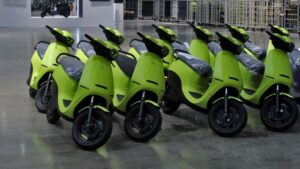
Ola Electric has decided to delay expanding its battery manufacturing plant beyond 5 GWh capacity. This change means the company won’t meet the government-set deadlines to receive benefits under the Production-Linked Incentive (PLI) scheme. Ola says it doesn’t need more than 5 GWh capacity until the financial year 2029 because it is now focusing more on profitability than fast growth.
Why the Delay?
The shift comes after Ola Electric saw its revenue fall by 50% year-on-year to ₹828 crore in April-June, and its losses increased to ₹428 crore. Despite this, the company achieved operational profitability in June for its electric vehicle (EV) business, which helped boost its stock price by 18%.


CEO Bhavish Aggarwal said that Ola may have to pay a penalty of up to ₹100 crore for missing the PLI targets. However, he believes the company can still be profitable without relying on government incentives for its battery cell plant.
Future Plans
- Ola will begin with 5 GWh of cell production.
- Once the business is stable, it plans to:
- Enter the battery storage market.
- Sell its own 4680 battery cells to other companies.
- Explore exporting its batteries.
Aggarwal mentioned that discussions are ongoing with the government to possibly change the PLI timeline.
Background
In 2022, Ola signed an agreement with the government to build 20 GWh battery capacity and planned to invest ₹225 crore per GWh in the first two years. Ola also raised ₹1,227 crore through its IPO in August 2024, originally intended to expand capacity to 6.4 GWh by April 2025. Now, the funds may be used differently.
Despite the changes, Aggarwal emphasized that building in-house battery cells is still a key part of Ola’s long-term vision. He pointed out the importance of having local manufacturing capabilities, especially given global challenges with rare earth materials.
This delay follows similar issues faced by other companies like Reliance New Energy and Rajesh Exports, which also received government notices for missing PLI deadlines. The government has not yet decided whether it will extend the timeline.
Read more: Ola Electric Shares Rise 17% After Strong FY26 Outlook, Better Q1 Results
Profit First Strategy
Ola is now focused on improving its profit margins. In the first quarter of this financial year, the EBITDA margin of its auto business improved from -90.6% to -11.6%. Ola sold 68,192 electric scooters and bikes during the quarter, beating its own guidance of 65,000.
For the full year, Ola expects to sell between 3,25,000 and 3,75,000 vehicles and earn ₹4,200–₹4,700 crore in revenue.
In a letter to shareholders, the company said it has shifted from a strategy of aggressive expansion to one of balanced and profitable growth. This year, it doesn’t plan to spend heavily on new growth projects for its EV business.
Also Read: Ola Electric Q1 Preview: ₹459 Cr Loss Expected, 90% Maharashtra Showrooms May Shut
Estimated Battery Needs
Ola also explained how much battery capacity it needs:
- One vehicle requires about 4 kWh of battery.
- 1.4 GWh of cell capacity can support around 3,00,000 vehicles.
- 5 GWh is enough for 12,00,000 vehicles per year.
Given the slower growth in the EV market recently, Ola says it doesn’t see a need to go beyond 5 GWh before FY29. The break-even point for the battery business is expected between 3.5 and 4 GWh.
Ola Electric is pressing pause on its big battery plant expansion plans to focus on becoming profitable. It will stick to a 5 GWh capacity until at least 2029, avoid heavy spending this year, and explore new business areas like battery exports and storage in the future.












